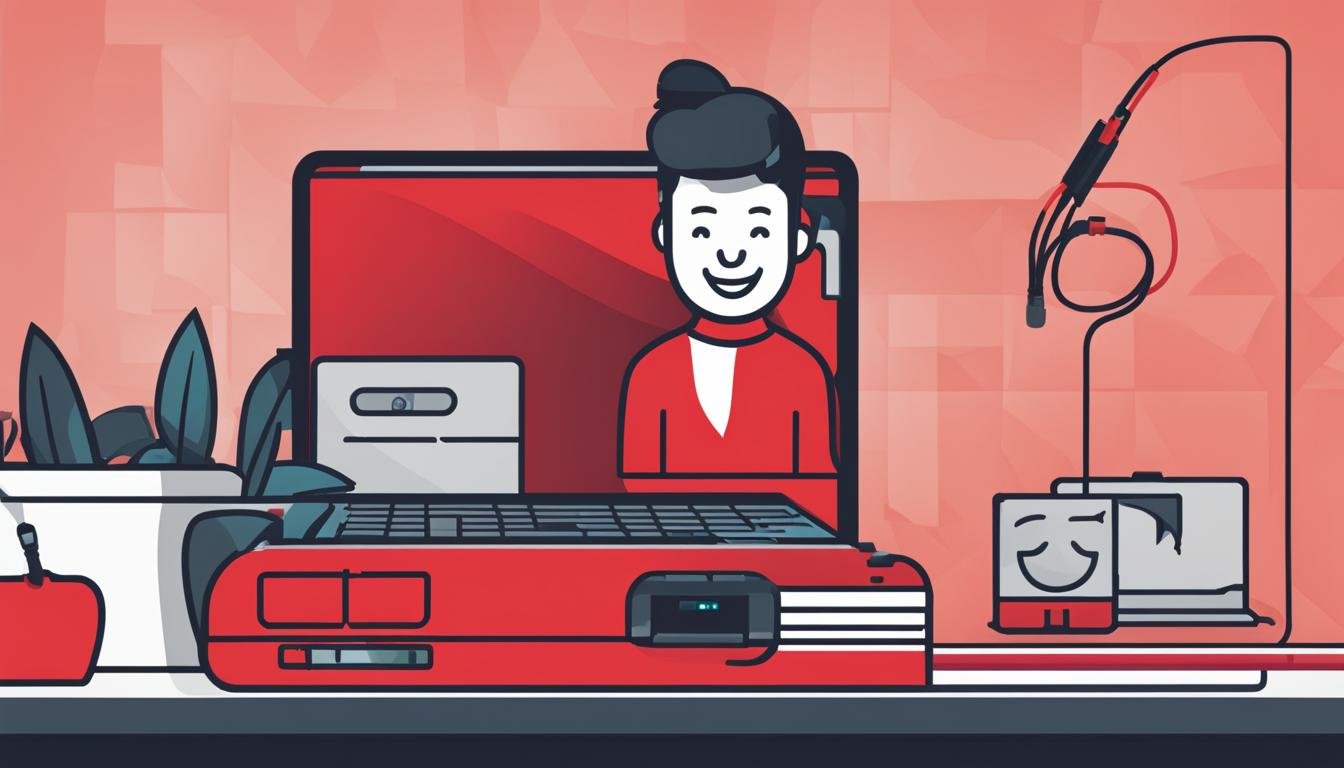Contents
- 1 Turn on the Battery Saver Mode
- 2 Check Battery usage by apps
- 3 Use Sleep Study Tool to Analyze Battery Drain
- 4 Troubleshoot Power problems with PowerCfg
- 5 Run Power Troubleshooter
- 6 Extend Battery life with customized Power Plans
- 7 Reinstall or Update Microsoft ACPI-Compliant Control Method Battery Driver
- 8 Perform Some Checks and Change the Battery and Charger
- 9 Conclusion
- 10 FAQ
- 10.1 How can I turn on the Battery Saver Mode on Windows 10?
- 10.2 How can I check the battery usage of each app on Windows 10?
- 10.3 How can I use the Sleep Study Tool to find out what drains my battery on Windows 10?
- 10.4 How can I troubleshoot power problems with PowerCfg on Windows 10?
- 10.5 How can I run the Power Troubleshooter on Windows 10?
- 10.6 How can I extend battery life with customized Power Plans on Windows 10?
- 10.7 How can I reinstall or update the Microsoft ACPI-Compliant Control Method Battery driver on Windows 10?
- 10.8 What should I do if basic checks and troubleshooting steps don’t fix the battery issues on my Windows 10 laptop?
- 10.9 How can I fix laptop battery issues on Windows 10?
Managing battery usage is crucial to ensure optimal performance and prolong the lifespan of your Windows 10 laptop’s battery. If you’re experiencing battery drain issues, there are steps you can take to resolve them effectively.
In this article, I will guide you through the necessary troubleshooting steps to fix battery-related problems on your Windows 10 laptop. By following these quick and easy steps, you can regain control over your battery power and enjoy extended battery life.
Key Takeaways:
- Enable Battery Saver Mode to conserve battery power and restrict background applications.
- Check battery usage by apps and restrict or remove power-draining apps.
- Use the Sleep Study Tool to analyze battery drain and identify specific issues.
- Utilize PowerCfg to troubleshoot power problems and generate detailed reports.
- Run the Power Troubleshooter to automatically detect and fix power-related issues.
Turn on the Battery Saver Mode
One of the key features available in Windows 10 to address battery drain issues is the Battery Saver Mode. This mode allows you to have better control over power consumption and restrict background applications, helping you extend your laptop’s battery life.
To enable the Battery Saver Mode on your Windows 10 laptop, follow these steps:
- Click on the “Start” menu and select “Settings.”
- In the Settings menu, click on the “System” option.
- From the left sidebar, select “Battery.”
- Toggle the switch under “Battery Saver” to turn it on.
Once you have activated the Battery Saver Mode, your laptop will automatically adjust certain settings to conserve battery power when the battery falls below a certain level.
“Battery Saver Mode helps optimize power consumption, allowing you to make the most out of your device even when the battery is running low.”
By turning on the Battery Saver Mode, you can effectively manage battery drain issues and prolong the battery life of your Windows 10 laptop. It is a convenient feature that ensures you have enough battery power in critical situations or when you don’t have immediate access to a power source.
Benefits of Battery Saver Mode:
- Reduces background activity, saving battery power.
- Adjusts screen brightness to conserve energy.
- Limits push notifications and other non-essential activities.
By activating the Battery Saver Mode, you can strike a balance between power efficiency and performance, ensuring that your Windows 10 laptop operates optimally even with limited battery resources.
| Battery Saver Mode | Normal Mode | |
|---|---|---|
| Background Activity | Reduced for improved battery life | Operates as usual |
| Screen Brightness | Automatically adjusts for energy conservation | User-defined settings |
| Push Notifications | Minimized to save battery power | Delivered as usual |
Activate the Battery Saver Mode and experience a noticeable improvement in your laptop’s battery life. It is a great option to ensure you make the most out of your device, even when you are away from a power source.
Check Battery usage by apps
To monitor and optimize your Windows 10 laptop’s battery consumption, it’s essential to keep track of which apps are using the most power. By checking the battery usage by apps, you can identify and control power-hungry applications, helping extend your laptop’s battery life.
To access this information, follow these simple steps:
- Go to the battery settings on your Windows 10 laptop.
- Click on the “Battery Usage by App” option.
This will display a comprehensive list of apps installed on your laptop along with their respective battery consumption percentages. By reviewing this list, you can quickly identify the apps that are draining your battery the most.
Once you have identified power-hungry apps, consider taking the following actions:
- Restrict app usage: Some apps may consume excessive power in the background, even when you’re not actively using them. Restricting their background activity can help conserve your battery. To do this, go to the app’s settings and look for options related to background activity or power usage.
- Disable or remove apps: If you find that certain apps are consistently draining your battery, you may want to disable or remove them from your system. This can help reduce unnecessary power consumption and improve overall battery performance.
By regularly checking the battery usage by apps and taking appropriate measures to restrict or remove power-draining apps, you can optimize your Windows 10 laptop’s battery consumption and enjoy longer battery life.
Use Sleep Study Tool to Analyze Battery Drain
The Sleep Study Tool is a powerful utility that can help you identify the processes and activities that are draining your laptop’s battery life. This tool is especially useful if your computer supports Windows InstantGo, as it provides detailed analysis and insights into battery drain while in sleep mode.
To use the Sleep Study Tool, follow these simple steps:
- Open the Command Prompt on your Windows 10 laptop by typing “Command Prompt” in the search bar and selecting it from the search results.
- In the Command Prompt window, type the following command:
powercfg /sleepstudy - Press Enter to run the command.
Once the command is executed, the Sleep Study Tool will generate a comprehensive report that outlines the various factors contributing to battery drain while your laptop is in sleep mode. This report can help you identify any problematic processes, apps, or settings that may be responsible for excessive battery consumption.
Analyzing the Sleep Study Report
| Component | Duration | Average Power |
|---|---|---|
| System Firmware | 2h 15m | 0.25W |
| Wireless Network Adapter | 1h 42m | 0.18W |
| Background Services | 1h 20m | 0.12W |
As you can see from the example table above, the Sleep Study Tool provides valuable information about the different components of your laptop and their power consumption during sleep mode. By analyzing this data, you can determine which components are draining your battery the most and take necessary actions to optimize power usage.
Tip: Look for components or processes that have a high duration and average power consumption. These are likely to be major contributors to battery drain.
Once you have identified the problematic components or processes, you can take the following steps to improve battery life:
- Update device drivers to the latest version.
- Disable unnecessary background apps and services.
- Adjust power settings to reduce power consumption.
By using the Sleep Study Tool and implementing the recommended optimizations, you can effectively manage battery drain during sleep mode and improve the overall battery performance of your Windows 10 laptop.
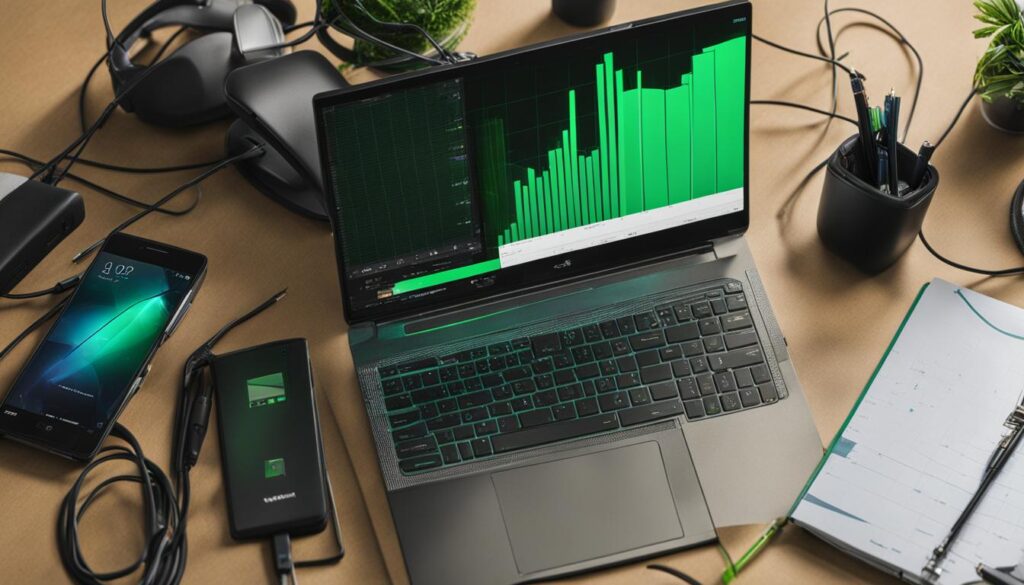
Troubleshoot Power problems with PowerCfg
If you’re facing power issues on your Windows 10 laptop, PowerCfg is a command utility tool that can help you diagnose and resolve them. PowerCfg scans your laptop for 60 seconds, assessing its power efficiency and identifying any issues that may be causing battery drain. It then generates a detailed HTML report that provides valuable insights into the causes of battery drain. To use PowerCfg, follow these steps:
- Open an elevated Command Prompt by right-clicking on the Start menu and selecting “Command Prompt (Admin)”.
- In the Command Prompt window, type
powercfg /energyand press Enter. This command initiates the power efficiency analysis for 60 seconds. - Wait for the analysis to complete. Once done, PowerCfg will generate a report that details the energy efficiency issues found on your laptop.
- Locate the report file, which is usually saved as “energy-report.html” in the current directory.
- Open the HTML report using a web browser to view the power efficiency diagnostics and recommendations.
Additionally, you can also generate a complete battery health report using PowerCfg. To do this, follow these steps:
- Open an elevated Command Prompt.
- In the Command Prompt window, type
powercfg /batteryreportand press Enter. This command generates a detailed report on your laptop’s battery health status and usage. - Locate the battery report file, which is usually saved as “battery-report.html” in the current directory.
- Open the HTML report using a web browser to access information about your battery’s performance, capacity, and usage history.
Common PowerCfg Commands
| Command | Description |
|---|---|
powercfg /energy | Scans the laptop for power efficiency issues and generates a detailed report. |
powercfg /batteryreport | Generates a comprehensive report on the laptop’s battery health and usage. |
powercfg /hibernate on | Enables the hibernation feature on the laptop. |
powercfg /hibernate off | Disables the hibernation feature on the laptop. |
Run Power Troubleshooter
If you’re facing power-related issues with your Windows 10 laptop, the Windows Power Troubleshooter can be a handy tool to automatically detect and fix these problems. To access the Power Troubleshooter:
- Open the Settings on your laptop.
- Navigate to the Update & Security section.
- Select Power in the Troubleshoot section.
- Click on the “Run the Troubleshooter” button.
The Power Troubleshooter will analyze your system, identify any power-related issues, and guide you through the troubleshooting process. This tool can help you resolve common power problems such as battery drain, unexpected shutdowns, or power management errors.
By running the Windows Power Troubleshooter, you can save time and effort by letting the tool automatically detect and fix power issues on your Windows 10 laptop, ensuring optimal performance and efficient power usage.
Remember, the Power Troubleshooter is just one of the many useful tools available to diagnose and resolve power-related problems. It’s always recommended to explore other troubleshooting steps to ensure a comprehensive approach to resolving any issues with your laptop’s power management.
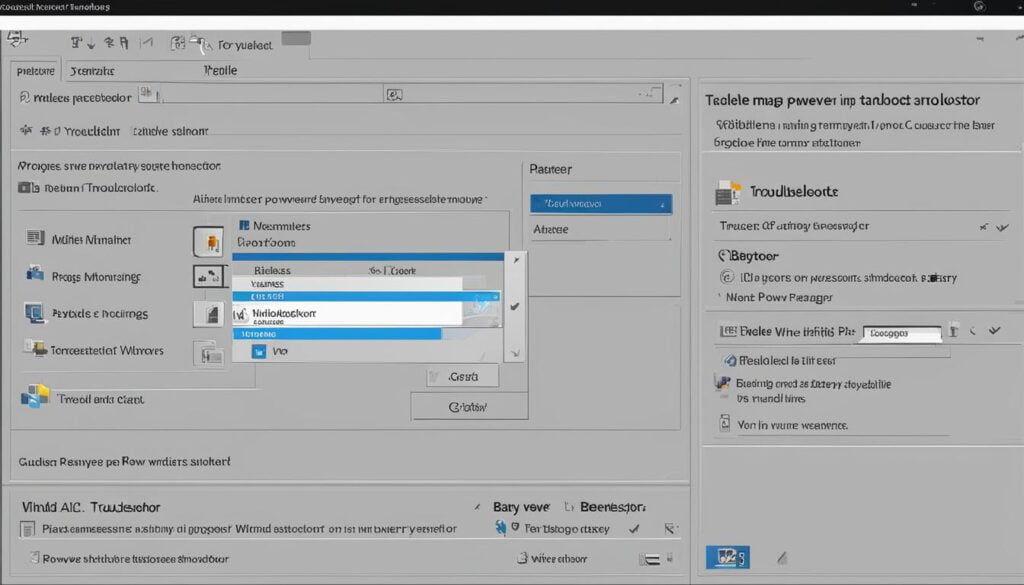
| Benefits of Running Power Troubleshooter | Troubleshooting Steps |
|---|---|
| Automatically detects power issues | Open the Settings |
| Guides you through the troubleshooting process | Navigate to Update & Security |
| Saves time and effort | Select Power in the Troubleshoot section |
| Ensures optimal performance and power usage | Click on “Run the Troubleshooter” |
Extend Battery life with customized Power Plans
When it comes to optimizing your Windows 10 laptop’s battery life, customized power plans are the key. By adjusting power settings according to your needs, you can conserve energy and optimize battery usage. This will ultimately help you extend the lifespan of your battery and enhance the overall performance of your device.
Power plans offer you the flexibility to prioritize between battery life and performance. With power plans, you can customize settings such as screen brightness, sleep mode behavior, and advanced power options. By tweaking these settings, you can strike the perfect balance between conserving energy and enjoying optimal performance.
Accessing power plans is a straightforward process. Simply go to the Control Panel and click on Power Options. From there, you can create a power plan that aligns with your preferences and adjust the settings accordingly.
Here are some key settings you can customize within your power plan:
- Screen Brightness: Adjust the brightness of your laptop’s display to an optimal level. Lowering the brightness can significantly reduce power consumption.
- Sleep Mode Behavior: Customize how your laptop enters sleep mode when inactive. Opting for shorter sleep times can help save battery power.
- Advanced Power Options: Access additional power settings such as processor performance, system cooling policy, and power button actions. Adjusting these options can further optimize battery usage.
By carefully configuring your power plan settings, you can maximize battery life while ensuring your laptop performs well for your everyday tasks.
Remember, each adjustment you make in your power plan can have a noticeable impact on your laptop’s battery life. It’s essential to strike the right balance between conserving energy and meeting your performance requirements.
Benefits of Customized Power Plans
Customized power plans offer several benefits to Windows 10 laptop users:
| Benefits | Description |
|---|---|
| Extended Battery Life | By optimizing power settings, you can extend the lifespan of your battery, reducing the need for frequent recharging. |
| Energy Conservation | Customized power plans help you conserve energy, minimizing the impact on the environment and reducing your electricity costs. |
| Improved Performance | By balancing power consumption, you can ensure your laptop runs smoothly and efficiently, delivering optimal performance. |
| Enhanced Productivity | With prolonged battery life, you can work on your tasks without interruptions, increasing your productivity levels. |
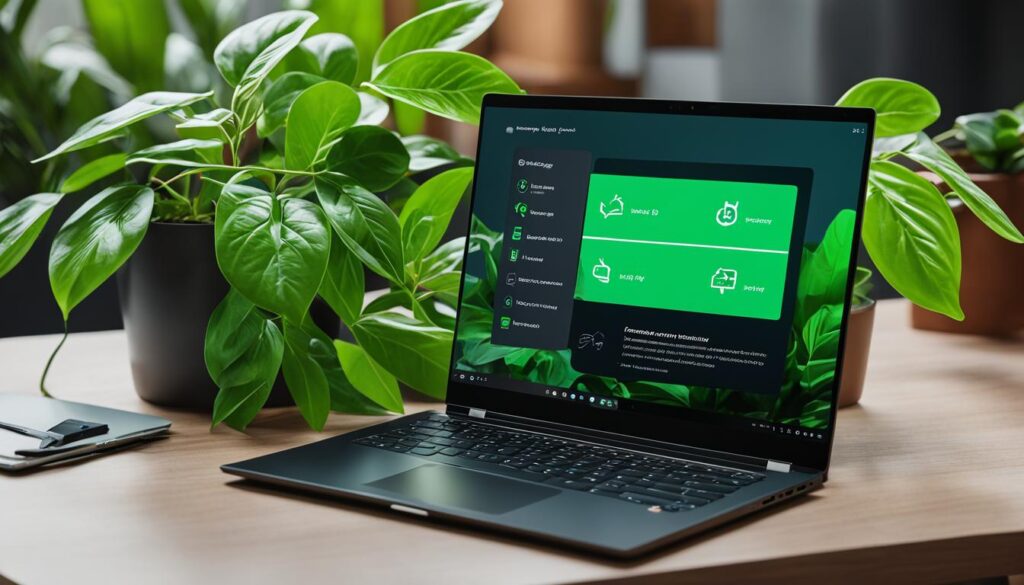
Optimizing battery usage is crucial for Windows 10 laptop users. By customizing power plans and adjusting relevant power settings, you can optimize battery performance, conserve energy, and extend the overall lifespan of your battery. Take control of your laptop’s power consumption and enjoy a seamless computing experience, both on the go and at home.
Reinstall or Update Microsoft ACPI-Compliant Control Method Battery Driver
Sometimes, I face battery driver issues on my Windows 10 laptop, which can cause battery-related problems. One possible reason for this is a corrupt driver. To resolve this issue, I can either reinstall or update the Microsoft ACPI-Compliant Control Method Battery driver.
Reinstalling the Driver:
If I suspect that the current driver is corrupt or malfunctioning, I can uninstall it from the Device Manager and then restart my laptop. Upon restarting, Windows will automatically reinstall the driver. Here’s how:
- Press the Windows key + X on my keyboard and select Device Manager.
- In the Device Manager window, expand the Batteries category.
- Right-click on Microsoft ACPI-Compliant Control Method Battery and select Uninstall device.
- Confirm the uninstallation and restart the laptop.
Updating the Driver:
If I prefer to ensure that my battery driver is up to date and functioning properly, I can choose to update it. Here’s how:
- Open the Device Manager by pressing the Windows key + X on my keyboard and selecting Device Manager.
- In the Device Manager window, expand the Batteries category.
- Right-click on Microsoft ACPI-Compliant Control Method Battery and select Update driver.
- Choose the option to Search automatically for updated driver software.
- Wait for Windows to search and install any available updates for the battery driver.
By either reinstalling or updating the Microsoft ACPI-Compliant Control Method Battery driver, I can resolve battery driver issues and ensure optimal performance for my Windows 10 laptop.
Perform Some Checks and Change the Battery and Charger
Before attempting any troubleshooting steps, it is crucial to perform some basic checks to pinpoint the source of the problem. By following these steps, you can identify if there is a fault with the battery or charger, ensuring an accurate resolution for your battery issues.
- Check the AC Outlet and Laptop Plugs: Ensure that the laptop is securely connected to the AC outlet and that the plugs are properly inserted. A loose connection can cause charging problems and may lead to ineffective battery performance.
- Inspect the AC Adapter for Damage: Examine the AC adapter for any signs of physical damage, such as frayed wires or bent pins. Faulty chargers can hinder the charging process and result in battery drain.
- Remove Dust Particles from the Charging Port: Over time, dust particles can accumulate inside the charging port, obstructing the charging mechanism. Carefully clean the charging port using a soft brush or compressed air to ensure uninterrupted power supply.
If you have performed these basic checks and are still encountering battery issues, it may be necessary to consider replacing the battery or charger. A faulty battery or charger can impede proper charging and significantly affect the performance of your laptop.
| Signs of a Faulty Battery | Signs of a Faulty Charger |
|---|---|
|
|
If you notice any of the above signs, it is recommended to replace the faulty battery or charger with a compatible and reliable alternative. This will ensure that your laptop receives a consistent power supply and resolves any charging-related issues you may be facing.
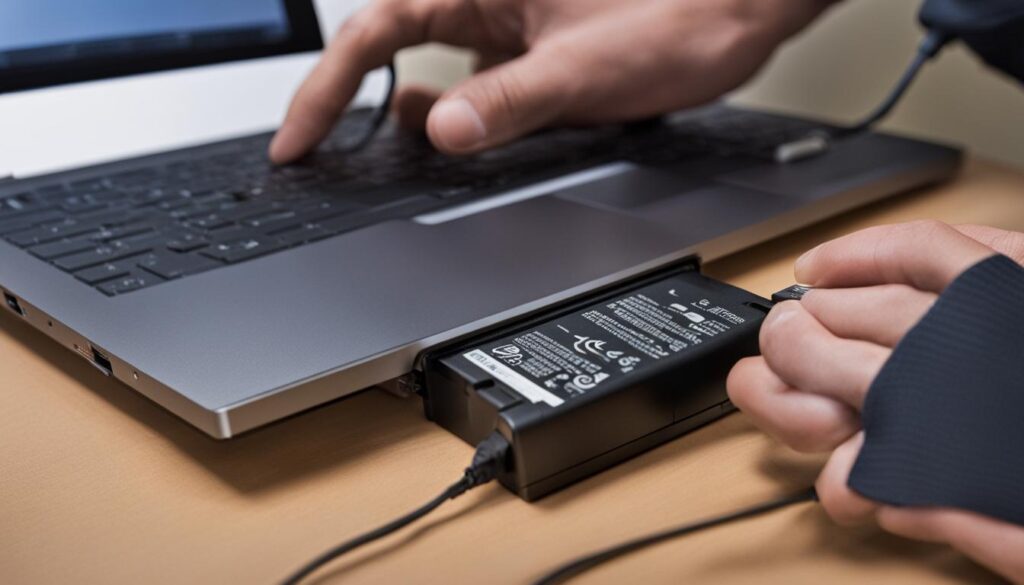
Note: Always refer to your laptop manufacturer’s guidelines and recommendations before replacing any hardware components.
Conclusion
Troubleshooting battery issues on a Windows 10 laptop can be resolved by following the steps outlined in this article. By enabling Battery Saver Mode, checking battery usage by apps, using power troubleshooting tools, and optimizing power plans, you can effectively fix most battery-related problems.
If you’re experiencing issues with your Windows 10 laptop battery not charging or draining too quickly, start by enabling the Battery Saver Mode. This feature helps control battery power consumption and restricts background applications, allowing you to conserve battery life.
Next, check the battery usage by apps in the Windows settings. Identifying the applications that are using excessive power can help you restrict their usage, disable them, or even remove them from your system, ultimately improving battery life.
If the issues persist, utilize power troubleshooting tools such as the Sleep Study Tool and PowerCfg to analyze battery drain and identify specific problems. You can also try running the Power Troubleshooter, a built-in tool that automatically detects and fixes power-related issues on your Windows 10 laptop.
Additionally, optimizing power plans through customizations can help you prioritize between battery life and performance. Adjusting settings such as screen brightness, sleep mode behavior, and advanced power options can significantly extend your battery life.
If all else fails, it may be necessary to consider replacing the battery or charger, especially if they are faulty and causing charging problems. Before doing so, make sure to perform basic checks, such as ensuring secure connections and checking for any damages, and consult the manufacturer if your laptop is still under warranty.
By following these troubleshooting steps and staying mindful of battery usage management, you can overcome laptop battery issues on your Windows 10 device and enjoy prolonged battery life and enhanced performance.
FAQ
How can I turn on the Battery Saver Mode on Windows 10?
To enable Battery Saver Mode on Windows 10, go to the Settings and click on the Battery option. From there, you can toggle the Battery Saver settings to turn it on automatically when the battery falls below a certain level.
How can I check the battery usage of each app on Windows 10?
To check the battery usage of each app, go to the battery settings on your Windows 10 laptop and click on the “Battery Usage by App” option. This will show you a list of apps and their respective battery consumption percentages. Identify the apps that are using excessive power and consider restricting their usage, disabling them, or removing them from your system.
How can I use the Sleep Study Tool to find out what drains my battery on Windows 10?
The Sleep Study Tool is a utility that helps you analyze what is draining your battery power on a Windows InstantGo-supported computer. By running the Sleep Study Tool, you can gather detailed information about the processes and activities that contribute to battery drain. This can help you identify specific issues and make necessary adjustments to improve battery life.
How can I troubleshoot power problems with PowerCfg on Windows 10?
PowerCfg is a command utility tool that scans your Windows 10 laptop to assess power efficiency and identify issues that may be draining battery life. It generates a detailed HTML report that provides insights into the causes of battery drain. To use PowerCfg, run the command “powercfg /energy” in an elevated Command Prompt. Additionally, you can generate a complete battery health report by typing “powercfg /batteryreport” in the Command Prompt.
How can I run the Power Troubleshooter on Windows 10?
The Windows Power Troubleshooter is a built-in tool that can automatically detect and fix power-related issues on your Windows 10 laptop. To access the Power Troubleshooter, go to the Settings, navigate to the Update & Security section, select Power in the Troubleshoot section, and click on the “Run the Troubleshooter” button. The Power Troubleshooter will identify any problems and guide you through the troubleshooting process.
How can I extend battery life with customized Power Plans on Windows 10?
Power plans allow you to prioritize between battery life and performance on your Windows 10 laptop. You can customize power settings such as screen brightness, sleep mode behavior, and advanced power settings. By adjusting these settings, you can optimize battery usage and extend battery life. To access power plans, go to the Control Panel and click on Power Options. From there, you can create a power plan that suits your needs and adjust the settings accordingly.
How can I reinstall or update the Microsoft ACPI-Compliant Control Method Battery driver on Windows 10?
Sometimes, issues with the Microsoft ACPI-Compliant Control Method Battery driver can cause battery-related problems on Windows 10 laptops. To fix this, you can uninstall the driver from the Device Manager and then restart your laptop to let Windows reinstall the driver. Alternatively, you can choose to update the battery driver to ensure it is up to date and functioning properly.
What should I do if basic checks and troubleshooting steps don’t fix the battery issues on my Windows 10 laptop?
Before trying any troubleshooting steps, it is important to perform some basic checks. Ensure that the AC outlet and laptop plugs are securely connected, check the AC adapter for any signs of damage, and make sure there are no dust particles inside the charging port. If all else fails, you may need to consider replacing the battery or charger if they are faulty and preventing proper charging.
How can I fix laptop battery issues on Windows 10?
Troubleshooting battery issues on a Windows 10 laptop can be resolved by following the steps outlined in this article. By enabling Battery Saver Mode, checking battery usage by apps, using power troubleshooting tools, and optimizing power plans, you can resolve most battery-related problems. If all else fails, considering replacing the battery or charger may be necessary. Remember to perform basic checks and consult the manufacturer if your laptop is still under warranty.
